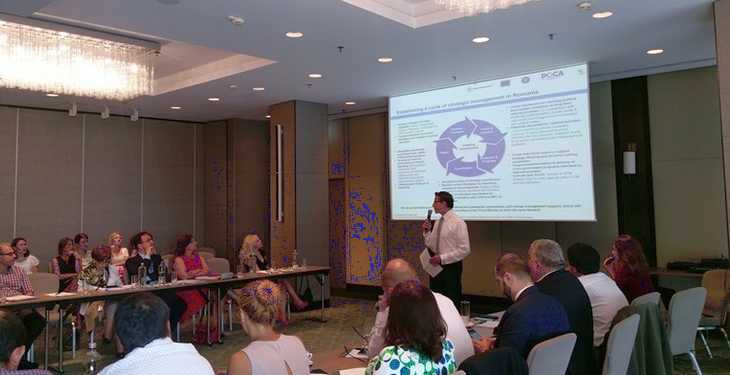”My first visit to Romania came almost 20 years ago, when I spent about six weeks working with the State Ownership Fund (SOF), looking at restructuring and turning around some of the broken down old factories from the communist era”, says Ismail Radwan, Lead Public Sector Development Specialist, World Bank Romania.
”That Romania was bleak, flat, and monochromatic – full of hard-faced people worn down by years of dictatorship that came to a sudden and bloody end that plunged most Romanians into a chaotic world where nothing seemed certain anymore. I traveled all around and heard the same stories of deprivation, cold winters without heating, a closed economy in which even news from the outside did not penetrate. It was a place where cooperation was impossible, as no one trusted anyone else.”
Romania looked different in 2013.
”Smiling, happy faces all around. At 5.2 percent growth in the first half of 2016, Romania is the fastest growing country in Europe, and full of young, talented people.”
What made the difference?
After the fall of communism, Romania had a single vision, a single mission. It was the goal of every political party to join the European Union. When Romania submitted the paperwork for EU membership, in 1995, it was accompanied by the famous Snagov Declaration signed by all 14 major political parties declaring their support for EU membership. With everyone in the country focused on the same target for more than a decade, Romanians managed to achieve all of their national goals – NATO and EU membership, the creation of a democratic society and a fast-growing, free-market economy. Goals that had seemed impossible only a few years earlier.
Having a national vision with the power to focus all the political, economic and social ambitions was the key. And that is what is missing in Romania today.
”At a recent conference on strategic management, I urged the audience to imagine a Romania that is prosperous, confident, and united; a Romania that is free from corruption; a Romania in which every child regardless of ethnicity, gender, or class has access to an excellent education; a Romania that provides world-class health care to all its citizens, taking care of the sick when needed and supporting the elderly through generous pensions. A Romania that is a leader among European nations and a role model for countries around the world to emulate. I truly believe that this future is possible. But it won’t happen without the creation of a national vision.”
Romania is growing, improving, and catching up with the rest of Europe in many ways. Romania has the fastest internet speeds in Europe and yet many rural areas are without internet and some villages even remain without electricity. ”Development is sporadic and haphazard. We dig the road one day to lay fiber cable and then we turn around and dig the road again next week to put in sewer pipes. We seem to be constantly digging the same roads to put new things under them, while we are unable to build the roads necessary to link us with the rest of Europe.”
Similarly, in the governance sector, we have created new institutions – such as the anti-corruption agency (DNA) or the national integrity agency (ANI) – but continue to subject them to pressures from politicians facing justice. To avoid this we need a detailed and systematic national vision, supported by the political class – as well as the discipline to implement it.
The vision needs to be developed inclusively – through extensive consultations – and we need to link that vision to a budget and implementation plan that can turn ideas into reality. We start with long range strategic foresight, scanning the horizon for challenges and opportunities, being proactive and dealing with issues that we know will come up in the future rather than waiting for them to hit us – such as active aging, climate change, technology, logistics and trade strategies. The next step is to move from that vision to strategies and programs that are realistic, time-bound, tied to a budget, and focused on results and outcomes.
Finally, a focus should be on introducing a robust methodology to monitor and evaluate progress, measure impact, and make changes and adjustments where necessary.
”To achieve this vision for Romania, we have been partnering with the Prime-Minister’s Chancellery since the beginning of the year. We found out that there are plenty of strategies – no fewer than 365 strategies, one strategy for every day of the year. In this jungle of strategies only the fittest survive – most of Romania’s strategies die before they are implemented.”
Why is that?
”Many strategies are unbounded – there is a vague wish to accomplish something but no timeline to achieve this. For example, 27 of 31 strategies by the Ministry of Transport are either undated or out of date. Two-thirds of the strategies developed in Romania do not mention a budget, less than one-third are correlated with the Institutional Strategy Paper – which lays out the strategy for the sector – and more than a third are a result of ex-ante conditionalities of the European Union rather than national priorities.”
This is where Romania is starting from.
”In partnership with the World Bank, we are trying to get to 100 percent of strategies informed by the national vision, linked to the budget, and linked to institutional strategy papers. Working together with the Government of Romania the World Bank can help strengthen national capacity to create and implement a strategic vision and all parts of the strategic management cycle illustrated above,” Radwan said.
”However, whether that technical capacity is utilized and allowed to play a role in determining the nation’s future, will require all Romanians to rally around a national consensus and a political leadership that is willing to work with all parties in parliament to turn plans into realities,” the World Bank expert concluded.
